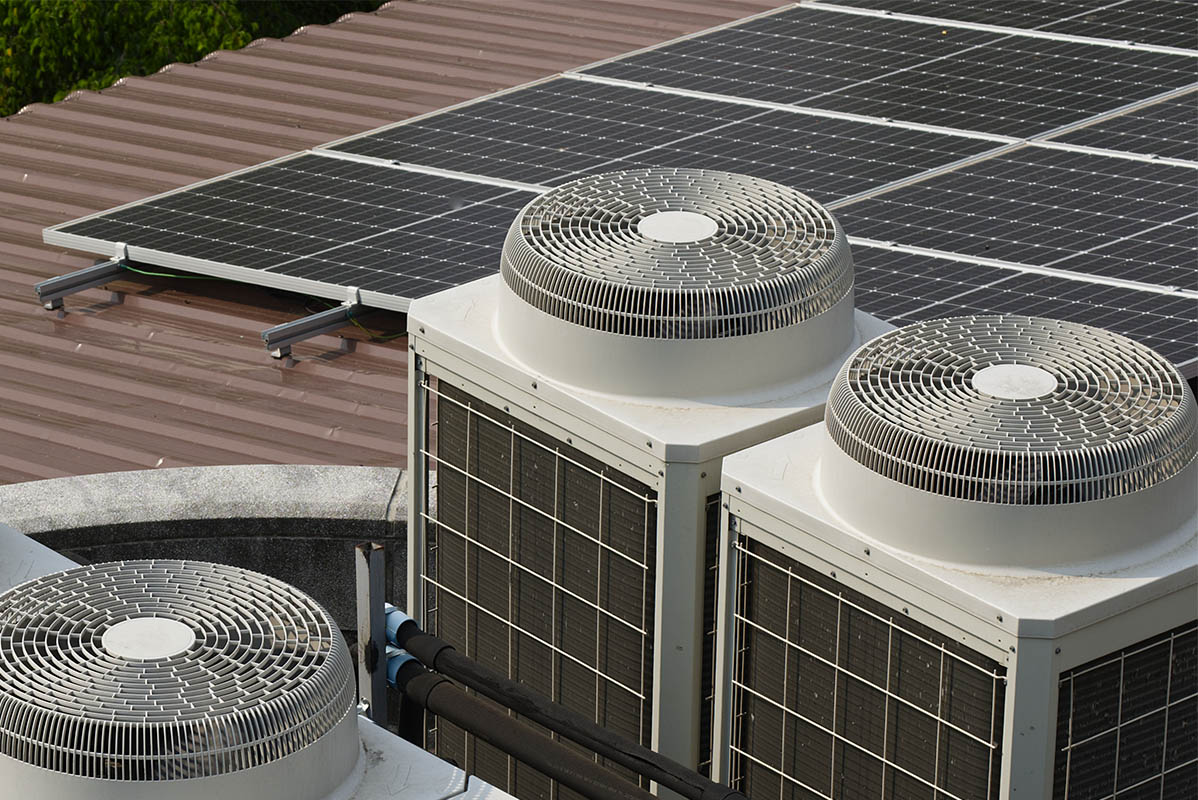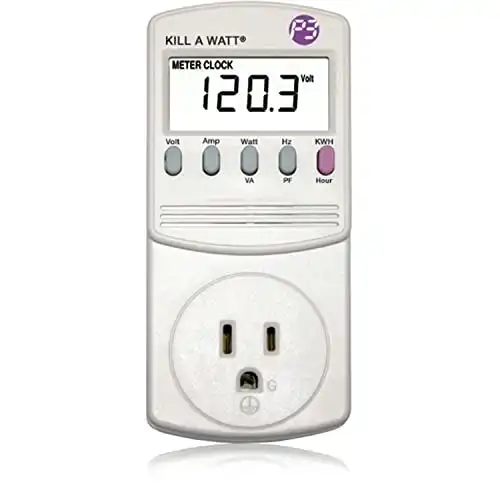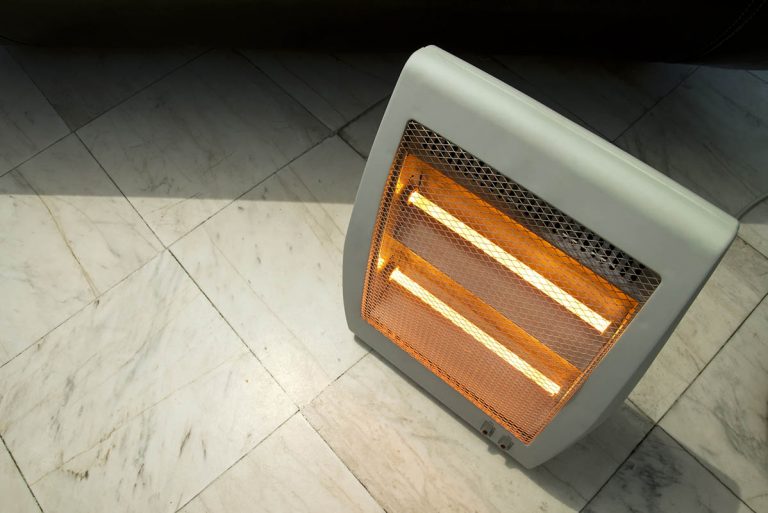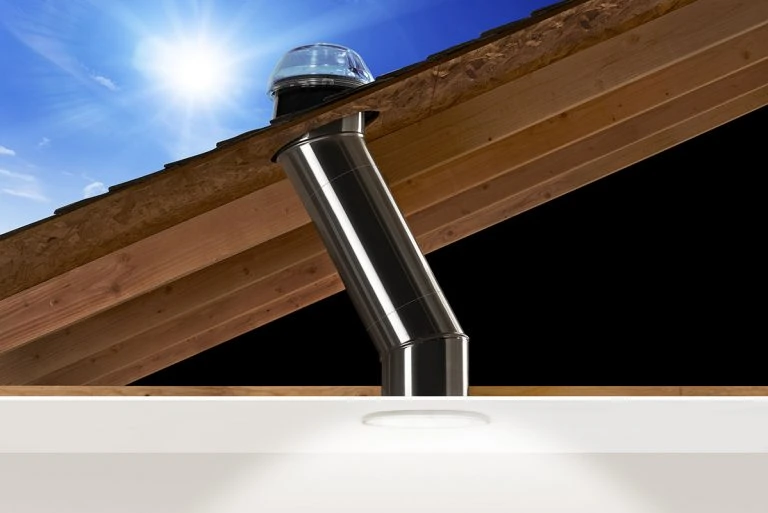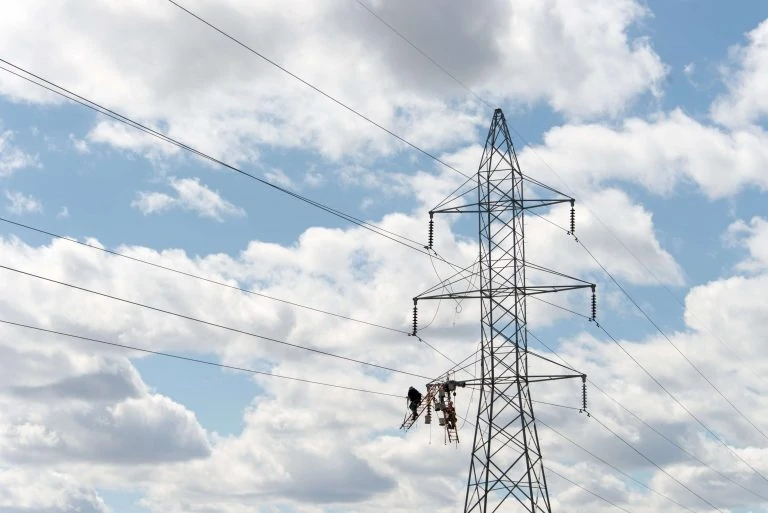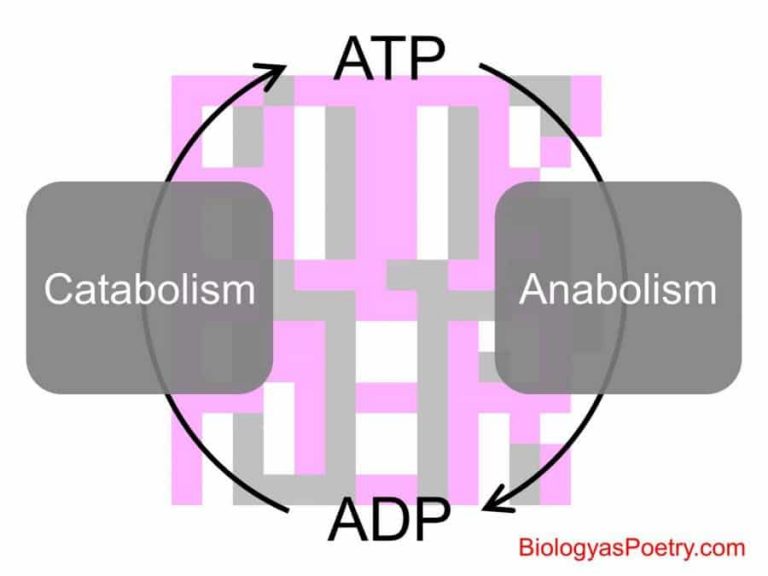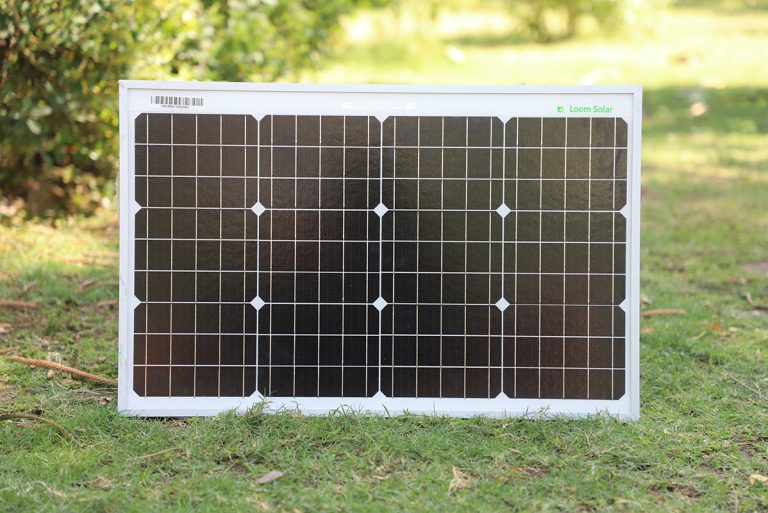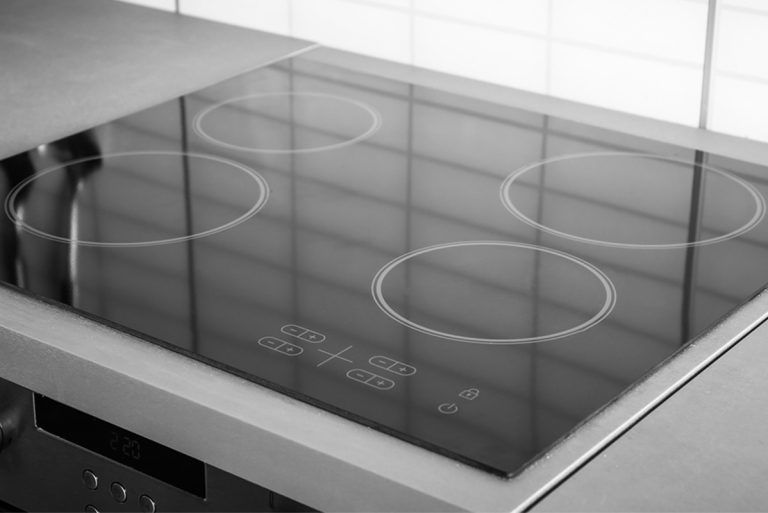The number of solar panels needed to run your air conditioner depends on a few factors – namely, the size of your air conditioning unit and the wattage of the solar panels.
As a general rule, you’ll need 1200 watts of solar panels for each ton of cooling power, which in practice translates into 20 x 300-watt solar panels to run a five-ton air conditioner.
How many solar panels are needed to run an air conditioner?
To answer this question, we need to explain a few things first, such as the power consumption of your AC and how you can determine the number of solar panels your specific air conditioning unit needs.
We’ll start by looking at the factors that determine how much power your AC uses.
What determines the power consumption of your AC?
There are many factors that impact on the amount of power your AC uses, from the weather to the location and type of building you have.
Weather
The first thing you need to consider in determining the power consumption of your air conditioner is the weather. Obviously, if the weather is hot, you’ll be using your air conditioner more and need more power to run it.
Furthermore, an air conditioner works by cooling the air. Therefore, if the ambient temperature is 105 degrees F, the AC needs to work harder to cool it down to a set temperature than if it is only 80 degrees F, for example.
Location
The climate where you live directly impacts how much you use your air conditioning, and how much energy your AC unit uses. So if you live in Texas, you’ll need more solar panels to run your AC than someone who lives in Minnesota.
By the way, Minnesota not only has a surprising amount of sun you can turn into renewable energy but also offers a range of incentives and rebates.
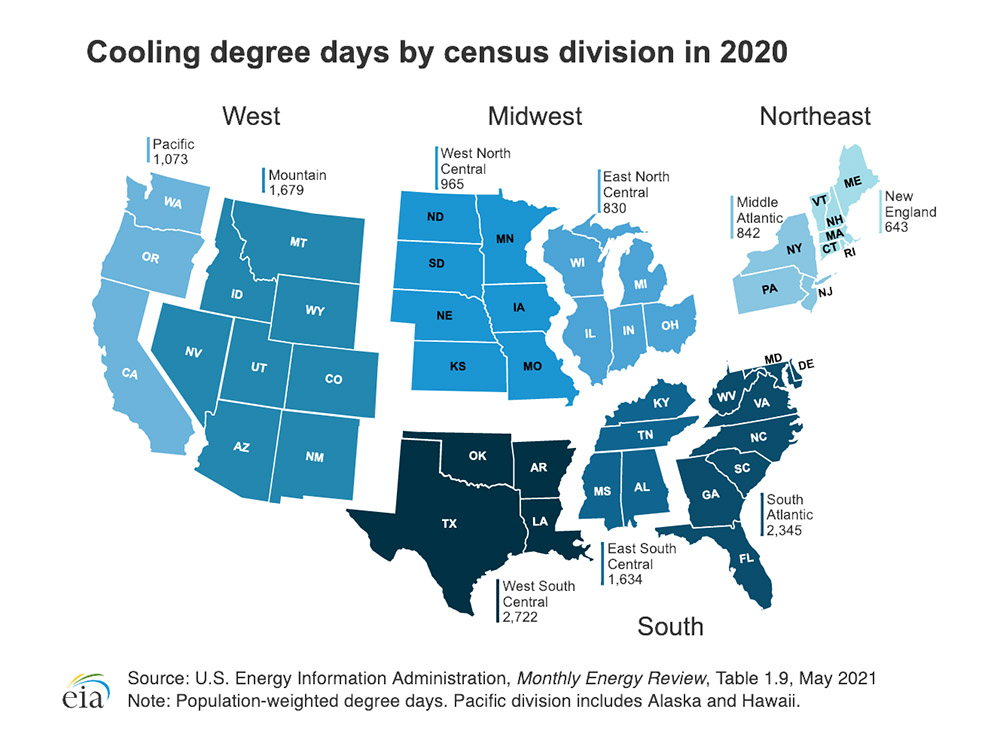
Source: EIA
In the same way, if your home receives a lot of shade, it will be more efficient to cool than a house with a lot of exposure to the sun.
The type of building
Energy-efficient building design can make a big difference here. For example, taller and more compact buildings are more efficient to cool than low, sprawling structures.
A roofline that protects your home from the hot, summer sun will also help keep it cool and reduce the need for AC. Similarly, insulation and double-glazed windows will make your house more efficient to cool, reducing the amount of energy your air conditioning system uses.
How to work out the power consumption of your AC
Determining the power consumption of your air conditioner, and therefore how many solar panels you’ll need to run it, is a little more complicated than some other types of appliances.
AC units do not draw a constant current unlike most appliances and devices because they run on compressors with motors that allow them to cycle on and off to maintain a temperature, the power they draw can go up and down.
Therefore, to work out the power consumption of your AC system, you need to average out the current.
How to average out the current of your AC system
You can do this with a Kill a Watt meter, a device that monitors the electrical usage of appliances.
Connect the Kill a Watt meter to your air conditioner for at least 24 hours and measure the power it draws over time. The meter measures in various units, including kilowatt-hours, AC volts, AC amps, and volt-amps.
To measure the power consumption of your air conditioner, you need to pay attention to the kilowatt-hours (KWH) and cumulative time hours and minutes. You can toggle between these readings on a Kill a Watt meter with the pink button on the right-hand side, and they’re displayed on the LCD screen – check the device’s manual for more instructions.
At the end of the 24 hours, take the kilowatt-hours and divide this by the cumulative hours and minutes as shown on the meter. This will show you the average kilowatt-hours used by your air conditioner.
How to determine the number of panels needed for your AC
For most appliances, you can work out how many solar panels you’ll need from a fairly easy calculation based on the watts the device uses per hour. However, things are a bit more complicated when it comes to AC systems.
Firstly, because aircon units cycle on and off, you need to average their energy use over time to determine how much power they use per hour.
Furthermore, AC is rated in tons rather than watts because different air conditioning units have varying efficiencies. Therefore, a unit’s electrical kilowatt rating isn’t an accurate measurement of its cooling power.
Instead, AC units are measured in tons. An AC rating of one ton translates into the ability to melt 2000 pounds of ice within 24 hours. So, the more tons, the more air the unit can cool every hour.
Although less common, one ton is sometimes represented as 12,000 BTU/h (British Thermal Units per hour) or 3.5 kW (kilowatt).
If you have four peak sun hours a day, you’ll need 1200 watts of solar panels for each ton of cooling capacity your AC has. Most modern air conditioning units have between two and five tons of cooling power.
We’ll take a look at a specific example next.
How many solar panels to run a five-ton AC unit
This is a somewhat complicated question because not all solar panels are the same. The solar panels used by private homes are typically between 100 and 250 watts. 250-watt solar panel provides more energy than a 100-watt one, so you’ll need more of the latter to run the same air conditioner.
You also need to consider the size of your air conditioner and how many hours you run your AC every day.
In the example of a five-ton air conditioner, say you run your AC for four hours a day, when temperatures are at their peak.
If the five-ton AC unit runs continuously during this time (which would be the maximum usage or “worst case” scenario), it will consume 24 kWh.
If you also have around four peak solar hours a day, which would be the case in summer for most climates, you can expect to receive around 300 watts of energy per hour from a 300-watt solar panel, which is equivalent to 1.2 kWh.
Therefore, you will need 20 solar panels of 300 watts each to produce 24kWh, enough for a five-ton air conditioner.
Energy backup
It’s essential to think about energy backup, as this will allow you to run your AC system at any time, including on gloomy days or overnight. This is an important consideration for any device you want to run on solar energy, particularly AC systems that we need to help us sleep on hot nights!
Your energy backup will depend on the type of solar system you have:
- If you have an off-grid solar system, you will need batteries to store energy during peak sun hours that you can later use to run your AC when there’s no sun.
- If your solar is tied to the central power grid, you can tap into the grid to supply power to your AC when solar is not available without needing battery backup.
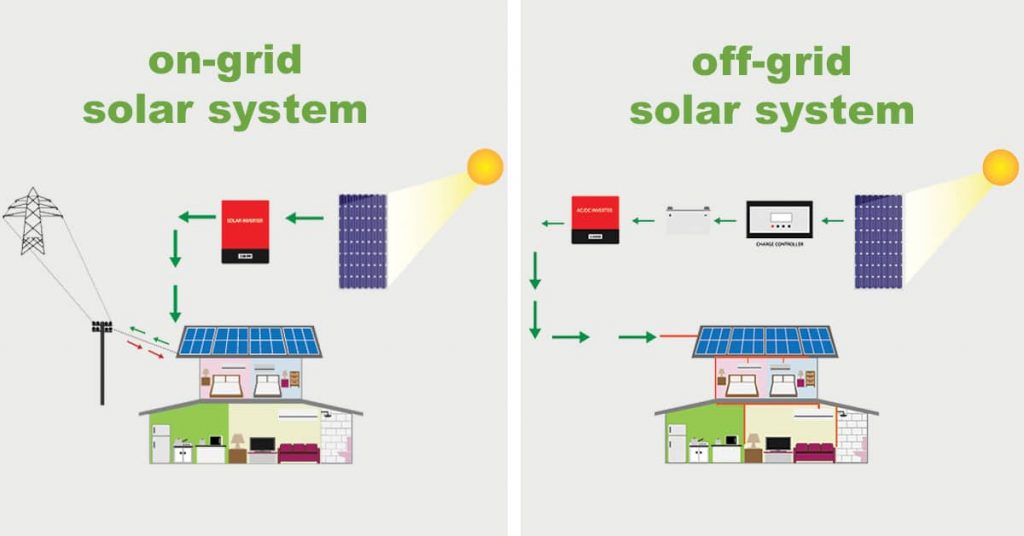
However, in the second set up, you won’t be running your aircon on purely renewable energy unless your energy provider uses sustainable energy sources such as wind or solar. Therefore, you may choose to include one or more batteries in your solar system, even if it’s tied to the grid.
Furthermore, a battery-supported solar system will mean that you always have access to AC, even during power outages.
This is doubly important for appliances like AC units which run on a motor to cycle power on and off because having a battery reservoir means you’ll always have enough power for motor surge current.
As a rough guide, you’ll need one 100Ah battery for each ton of cooling capacity and each hour of running time.
Final thoughts
The short answer: for a five-ton air conditioner, you’ll need 20 x 300-watt solar panels to run your AC for four hours a day during peak temperatures.
To work out how many solar panels you need for your own air conditioner, you’ll need to think about the size of your AC unit, the number of watts of each solar panel, as well as other environmental factors such as the weather and the design and location of your home.
It’s also important to consider battery backup to make sure you can run your air con whenever you need it, including overnight.
If you’ve found this guide to how many solar panels to run an air conditioner helpful, check out our other guides such as pros and cons of ground mount solar systems and geothermal heating, and go ahead and share this article on social media.

